An altar traditionally serves as a sacred platform for offerings and prayers, symbolizing divine connection, whereas a sacrificial stone primarily functions as a physical surface for animal sacrifices in ancient rituals. Discover the deeper religious and cultural distinctions between altars and sacrificial stones in this article.
Table of Comparison
| Aspect | Altar | Sacrificial Stone |
|---|---|---|
| Definition | A raised structure for offerings and worship rituals. | A flat or carved stone used specifically for animal or object sacrifices. |
| Purpose | Facilitate various rituals including prayers, offerings, and ceremonies. | Designated for blood sacrifices and ritual slaughter. |
| Material | Stone, brick, or wood, often ornate. | Natural or hewn stone, typically flat and durable. |
| Location | Temples, homes, or sacred spaces. | Outdoor ritual sites or temple courtyards. |
| Symbolic Meaning | Connection between humans and divine beings. | Atonement, purification, and sacrifice. |
| Examples in Tradition | Christian altars, Hindu puja altars, ancient Greek altars. | Ancient Jewish sacrificial stones, Aztec sacrificial platforms. |
Introduction to Altars and Sacrificial Stones
Altars serve as sacred platforms in religious rituals where offerings or sacrifices are made to deities, symbolizing a point of communication between the divine and worshippers. Sacrificial stones, often integrated within or alongside altars, are rugged surfaces used specifically for the act of sacrifice, highlighting their functional role in the ritualistic process. Understanding the distinction between altars and sacrificial stones reveals their complementary roles in ancient and modern worship practices, emphasizing both the spiritual and practical elements of sacrificial rites.
Historical Overview of Altars
Altars have served as sacred platforms for offerings and rituals across various cultures, dating back to ancient Mesopotamia and Egypt where they symbolized a connection between humans and deities. Sacrificial stones, often integrated within altar structures, provided durable surfaces for animal sacrifices in civilizations such as the Greeks and Romans, emphasizing ritual purity and permanence. Your understanding of altars deepens by recognizing their evolution from simple stone slabs to elaborate ceremonial sites central to religious practices worldwide.
Origins and Uses of Sacrificial Stones
Sacrificial stones originated in ancient religious practices as designated altars for offerings to deities, often found in prehistoric and early civilizations. Unlike traditional altars, which may be wooden or constructed from various materials, sacrificial stones are typically large, flat rocks specifically carved or positioned for ritual sacrifices. Your understanding of these sacred artifacts reveals their primary use in ceremonies involving animal or grain offerings to invoke divine favor or atonement.
Key Differences Between Altars and Sacrificial Stones
Key differences between altars and sacrificial stones center on their structure and purpose; altars are often constructed platforms used for various religious rites, while sacrificial stones are typically flat, natural rock surfaces designated specifically for offerings. Altars may serve multiple ceremonial functions beyond sacrifice, including prayer and place of worship, whereas sacrificial stones are primarily focused on the act of sacrifice itself. Your understanding of these distinctions enhances the interpretation of ritual practices in historical and cultural contexts.
Religious and Cultural Significance
Altar, sacrificial stone, and altar each hold distinct religious and cultural significance, symbolizing sacred spaces for worship and ritual offerings across various traditions. Your understanding of altars reveals them as central places for prayer and divine communication, while sacrificial stones serve as the foundational site for rituals involving offerings and sacrifices, reflecting ancient practices of appeasement and devotion. These elements collectively embody the convergence of spirituality and cultural heritage, highlighting humanity's enduring relationship with the divine through physical manifestations of faith.
Material Composition and Construction
Altar, sacrificial stone, and altar vary significantly in material composition and construction, reflecting their distinct religious functions. Altars are typically constructed from durable materials like stone, wood, or metal, designed for ritual offerings and ceremonies, emphasizing stability and symbolism. Sacrificial stones are often unhewn, raw stone slabs serving as simple, ancient platforms for sacrifices, highlighting their primitive and functional nature while altars can feature intricate designs tailored to specific religious traditions.
Ritual Practices Involving Altars
Ritual practices involving altars often differentiate between altars, sacrificial stones, and traditional altar platforms based on their function and cultural significance. Altars typically serve as designated spaces for offerings and prayers, while sacrificial stones specifically cater to animal or symbolic sacrifices within ceremonies. Understanding these distinctions enhances your ability to engage with varied religious rituals and their profound spiritual symbolism.
Sacrificial Stones in Ancient Traditions
Sacrificial stones in ancient traditions served as pivotal ritual platforms, distinct from altars by their typically flat, unadorned surfaces used for offerings and sacrifices. Unlike constructed altars often elevated and built from various materials, sacrificial stones were natural or shaped rock formations symbolizing a direct connection to the earth and divine presence. Your understanding of these sacred objects highlights their integral role in ceremonies, where they acted as tangible links between humans and the spiritual realm.
Symbolism and Spiritual Meaning
Altar, Sacrificial Stone, and Altar each hold profound spiritual symbolism representing different facets of worship and connection to the divine. Your altar symbolizes a sacred space for prayer and offerings, embodying a direct link to spirituality and reverence. The sacrificial stone emphasizes sacrifice and atonement, reflecting a profound commitment to faith, while the altar serves as a place of communion, embodying holiness and divine shelter.
Contemporary Perspectives and Interpretations
Contemporary perspectives differentiate altars, sacrificial stones, and altar tables by their symbolic and functional roles in religious practices; altars commonly serve as central ritual platforms for offerings and prayers, while sacrificial stones specifically emphasize ancient sacrificial rites and continuity with historical traditions. Modern interpretations often view altars as inclusive spaces for spiritual reflection, transcending purely sacrificial connotations, whereas sacrificial stones are studied for their archaeological and cultural significance in early worship contexts. The evolving understanding of these entities highlights a shift towards more diverse and personalized religious experiences, reflecting changes in theology and ritual practice in contemporary spirituality.

Infographic: Altar vs Sacrificial Stone
 relatioo.com
relatioo.com